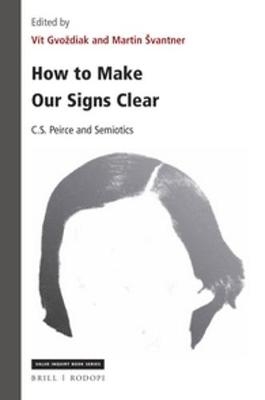
How to Make Our Signs Clear
Brill (Verlag)
978-90-04-34777-9 (ISBN)
How to Make Our Signs Clear is the result of an international cooperation between European and Brazilian Peircean scholars (I. A. Ibri, E. Višňovský, C. Paolucci and others) and strives to dispel simplifications of Peirce´s semiotic as well as to collect various insights into it and into its consequences for philosophy, especially philosophy of language, pragmatism and epistemology. The central theme of this book is the notion of the sign as a specific triadic relational unit, treated from various perspectives and applied to various fields of philosophy: semeiotic knowledge grows up from the discussions, common interests and possible conflicts between the readers of Peirce´s works. This book does not offer a general overview of Peirce´s theory of signs, but rather various analyses of consequences of some capacities of his semiotic.
Martin Švantner, Ph.D. (1982) is assistant professor at the Department of Electronic Culture and Semiotics, Charles University, Prague and at the Department of Sociology, Faculty of Arts, Pilsen. His professional interest focuses on C. S. Peirce´s semiotic, theoretical rhetoric and history of semiotics. Vít Gvoždiak, Ph.D. (1983) is researcher at the Institute of Philosophy, the Czech Academy of Sciences. His professional interest focuses on theoretical semiotics and comparative theory of signs.
List of Abbreviations
Notes on Contributors
1 Introduction
Vít Gvoždiak and Martin Švantner
2 On the Interconnection between Peirce’s Pragmatism and Semiotics
Emil Višňovský
3 Habits, Purposes and Pragmatism
Henrik Rydenfelt
4 Logic of Relatives and Semiotics in Peirce. From the “Subject-Predicate” Inferential Structure to the Synechistic Topology of Interpretation
Claudio Paolucci
5 Reflections on the Presence of Peirce’s Category of Firstness in Schelling’ and Schopenhauer’s Philosophy
Ivo Assad Ibri
6 Charybdis of Semiotics and Scylla of Rhetoric. Peirce and Gorgias of Leontini on the Rhetoric of Being
Martin Švantner
7 “When You Find a Crossroad, Take it”, Or, How to Do the Right Thing, Although Not for the Right Reasons
Emanuele Fadda
8 Jakobson and Peirce: Deep Misunderstanding, or Creative Innovation?
Vít Gvoždiak
9 Hopes of Derrida’s Reading? On Emergence of Peirce’s Texts in the Poststructuralist Context
Michaela Fišerová
10 Gilles Deleuzeʼs Theory of Sign and Its Reflection of Peircean Semiotics
Martin Charvát and Michal Karľa
11 Charles Peirce and the Theory of Disembodiment
Stephanie Schneider
Index
| Erscheinungsdatum | 03.02.2018 |
|---|---|
| Reihe/Serie | Value Inquiry Book Series / Central European Value Studies ; 305 |
| Verlagsort | Leiden |
| Sprache | englisch |
| Maße | 155 x 235 mm |
| Gewicht | 300 g |
| Themenwelt | Geisteswissenschaften ► Philosophie ► Erkenntnistheorie / Wissenschaftstheorie |
| Geisteswissenschaften ► Philosophie ► Sprachphilosophie | |
| ISBN-10 | 90-04-34777-1 / 9004347771 |
| ISBN-13 | 978-90-04-34777-9 / 9789004347779 |
| Zustand | Neuware |
| Haben Sie eine Frage zum Produkt? |
aus dem Bereich


![Was heißt Denken?. Vorlesung Wintersemester 1951/52. [Was bedeutet das alles?] - Martin Heidegger](/media/113619842)